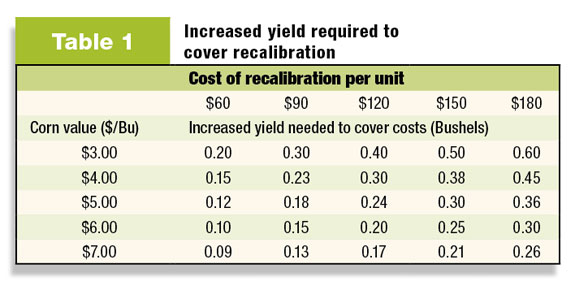Corn growers are constantly looking for ways to maximize profit. Planter condition is one of the most controllable variables that influence profitability. Research studies have shown that planter maintenance impacts the quality of stand establishment. In 2000, researchers conducted a study which showed an average yield improvement of 4.2 bushels per acre due to planter calibration.
At some locations, the advantage for calibration exceeded 20 bushels per acre. A research study conducted at Purdue showed yield losses in the range of 7 to 15 bushels per acre were observed in uneven stands.
One way for corn growers to potentially increase yields with minimal input costs is by improving within-row plant spacing uniformity.
Proper planter maintenance, adjustment and speed result in optimal seed placement. Replacement of worn-out parts (e.g. finger sets, brushes, backing plates, disks, coulters, etc.) and the calibration of planter units play a major role in maintaining consistent seed placement and depth, which impact spacing between plants. Uniform stands reduce competition between plants and take advantage of sunlight to maximize yields.
Fine-tuning planter seed meters will position producers to grow uniform stands that will maximize profits.

The yield increase needed to just offset the cost of planter meter calibration for a 600-acre corn grower using a 12-row planter is only 0.5 bushels per acre. Table 1 shows that recalibration management decision is valid over a range of corn prices and calibration costs.
Industry representatives recommend planter units be recalibrated every 75 to 100 acres per row unit or every three years. The farm-level impact on profitability can be quite significant.
A producer who plants 300 acres of corn each year with a six-row planter should calibrate his planter every two years.
Table 2 shows the benefits of recalibrating a corn planter.

Assumptions for Table 2 are:
- six-row planter
- 300 acres corn planted
- recalibration cost $35 per unit
- replacement parts $85 per unit
- corn price $5.50 per bushel
- increased yield due to unit recalibration 4 bushels per acre
Non-uniformity in corn stands places a growerâs sizable investment in their planter, seed and other inputs at risk of lower returns.
Many times producers forget the impact that skips (missing plants), doubles, triples and inconsistent plant spacing have on reducing corn yields. Replacement of worn-out parts and recalibration of planter units is an easy way to minimize production risk and maximize yields and profits. PD
References omitted due to space but are available upon request to editor@progressivedairy.com
âExcerpts from Virginia Cooperative Extension Farm Business Management Update, January 2012





